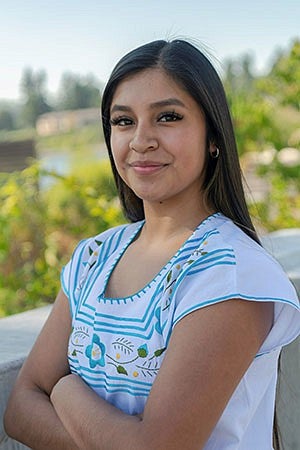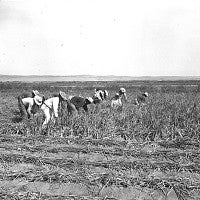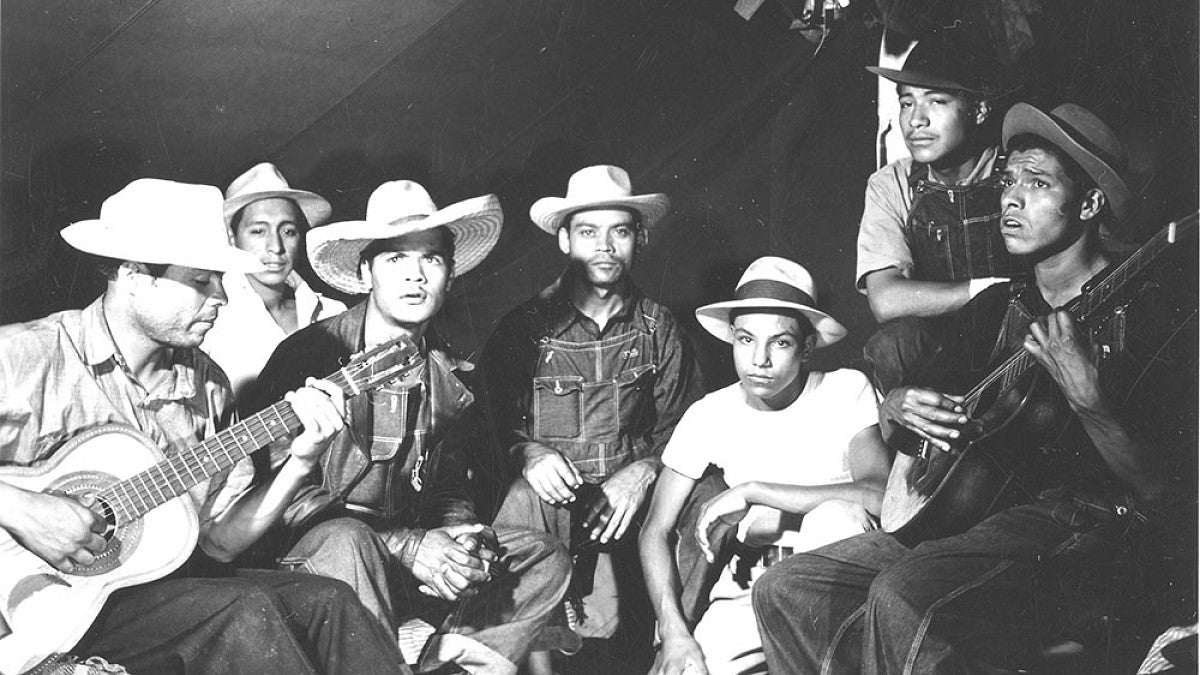
At the UO, Aguilar-Aguilar chose to major in Latin American studies and Spanish. When history professor Julie Weise invited her to work on a research project that involved the Bracero farm worker program, Aguilar-Aguilar jumped at the chance to learn more. She especially wanted to examine a group that had been largely ignored—the wives, women, and children whose husbands, fathers, brothers, uncles, and cousins went north seeking better-paying work on US farms, fields, and ranches.
RELATED LINKS
“Women’s and children’s lives were definitely impacted after their fathers or siblings or other family members left,” says Aguilar-Aguilar, who has family members who were farm workers in the US under different types of contracts. “Women were forgotten in the shadows, and it’s important for their stories to be highlighted, as well as the men’s.”
Rich promises, harsh realities
The Bracero (meaning “a man who works with his arms”) program was instituted in 1942 to assure plentiful, cheap labor for a US agriculture industry facing a shortage of workers due to World War II. Lured by promises of high wages, basic health care, and other benefits, between 1942 and 1964 more than four million Mexican farm workers left their rural homes and headed north. Once in the US they encountered the program’s far harsher realities—month-long waits for job assignments, paltry wages for back-breaking work, rationed water, men and teenagers packed together in sweltering Quonset huts without adequate sanitation, water, or medical care.

Aguilar-Aguilar wants to hear their stories and plans to share them in a research paper she hopes to submit for publication.
She has reviewed hundreds of oral histories in the Smithsonian’s Bracero History Archive, a digital project about the program that includes documents, images, history, and other resources. She first read synopses of 200 or so transcribed interviews, most of which are in Spanish, and made notes of which ones contained relevant material. As her research develops, she will review these interviews closely, tagging them for specific themes such as “the emotional toll of migration” or “what the program meant for men and their families.”
Amongst the transcripts, she has found wrenching testimony from sources, such as Elsa Murillo Rodríguez, who remembered how it felt growing up with an absent father:
“My childhood was sad because the majority of it, my father was not with us because he was working for us in the United States . . . We needed him at home with my mother and my siblings. We were six siblings. He would spend his time [in the US] and we would be alone at the ranch."
Perfect for a project
Weise and Aguilar-Aguilar are collaborating using an approach more often seen in science research than in the humanities. In this model, Weise explains, “a student takes on a piece of a professor’s research and contributes to a larger project, but also develops their own publication out of the same data.”
Weise, an associate professor of history, studies identity, citizenship, migration, and race in the US, Latin America, and globally. Currently she is examining post-WWII labor migration between several countries, including Mexico and the US, with a focus on labor contracts, working conditions, and family relationships. The two met when Aguilar-Aguilar was in Weise’s Latinos in the Americas class in January 2019. Aguilar-Aguilar’s academic chops, enthusiasm, and commitment were immediately apparent, and when Weise came up with the idea to collaborate with a student on a research project, she knew Aguilar-Aguilar was the “perfect person to think about developing a project together.”
Aguilar-Aguilar says she felt an immediate draw to working with Weise: “I had already taken classes and knew some of the history [of the Bracero program]. The work I am doing will benefit both of us.” Aguilar-Aguilar received a research fellowship from UO’s Office of the Vice President for Research and Innovation, which enabled her to spend her summer on the project.
“A very intensive mentorship”
Aguilar-Aguilar’s tagging of the oral histories will serve Weise’s work, as well. The student will flag material that fits her professor’s research questions—quotes pertaining to themes such as decisions by the farm workers or “Braceros” to join the program rather than migrate without the necessary entry documents, for example, or actions Braceros took when employers did not honor their contracts.
Aguilar-Aguilar also receives “a very intensive mentorship in research methods,” Weise says. This past summer, the two met weekly over Zoom. Weise guided Aguilar-Aguilar to the relevant literature and worked with her to compile research questions to use when reviewing the oral histories. Aguilar-Aguilar drafted a paper this summer, will take a senior research seminar with Weise next spring to learn about advanced research methods, and will then expand the paper, possibly into an honors thesis.
“She is so motivated, to change the world, to learn,” Weise says. “She cares so much, and is smart about the way she thinks about these things. She’s a rising star.” While at the UO, Aguilar-Aguilar has received a PathwayOregon scholarship, the Benjamin A. Gilman International Scholarship, the Mills Study Abroad Scholarship, and a Global Education Oregon Scholarship for First-Generation College Students.
“I really enjoy doing this type of research,” Aguilar-Aguilar says. “I’m not going to lie—it’s been a bit of a challenge as I have another full-time job, which means I work 12-hour days, Monday through Friday, and also work on the weekends. But I could listen to the interview recordings all day. I find their stories fascinating and believe immigrant workers, whether documented or not, deserve much more recognition for their great contribution to this country.”
By Alice Tallmadge, MA ’87 (journalism), a contributing editor for Oregon Quarterly.
Images in the body of the story are courtesy of the Extension Bulletin Illustrations Photograph Collection (P 020); Agriculture Photograph Collection (P 040); and Extension and Experiment Station Communications Photograph Collection (P 120); Oregon State University Special Collections and Archives Research Center, Corvallis, Oregon.


